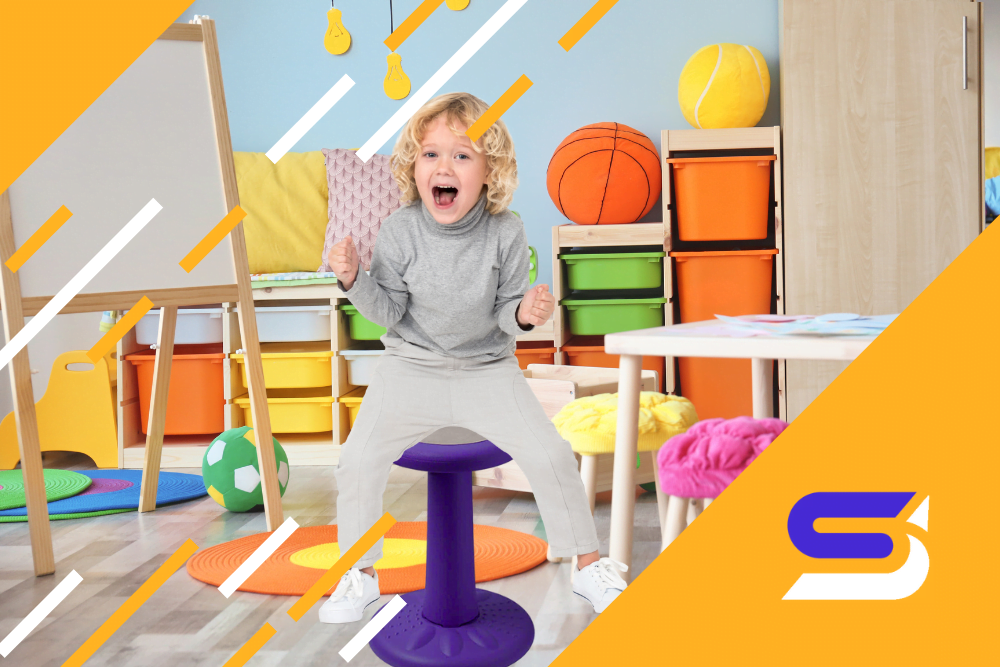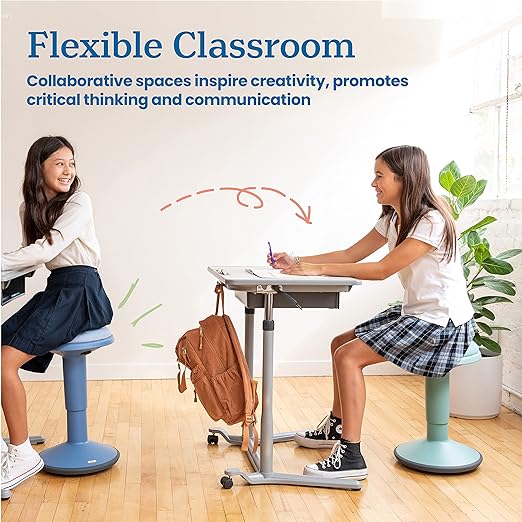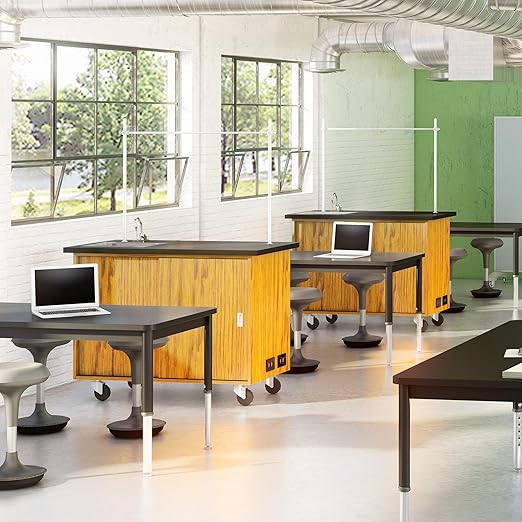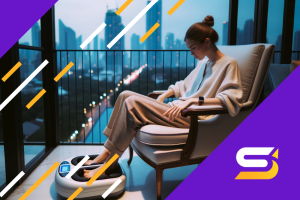The Benefits of ADHD Chairs
ADHD chairs are designed to help children with attention deficit hyperactivity disorder (ADHD) improve their focus, posture, and sensory processing. These ergonomic seating options provide a comfortable way to promote better posture and focus in children with ADHD through features like adjustable height and angle, swivel base, and textured surfaces. This section will explore the advantages of utilizing an ADHD chair.
Improved Focus Through Active Sitting
Active sitting is where individuals engage their core muscles while seated, leading to increased concentration levels. The design of ADHD chairs encourages active sitting by allowing users to move freely without feeling restricted or confined. This movement helps stimulate blood flow throughout the body, leading to improved mental clarity and overall cognitive function for those struggling with ADHD symptoms.
Better Posture for Long-Term Health Benefits
If not addressed early in life, poor posture can lead to health issues such as back pain, neck strain, headaches, or long-term spinal problems. With adjustable height settings along with other ergonomic features found in many ADHD chairs, like swivel bases or tilt functions, these seating options allow users customization according to individual comfort preferences, ultimately promoting healthier postures during use.
- Ergonomic Design: The design of an ADHD chair supports proper spine alignment while seated.
- Adjustable Height: Users can easily adjust the chair’s height according to their needs, ensuring optimal support at all times.
- Tilt Functionality: Some models offer tilt functions allowing users to recline or lean forward as needed, further enhancing comfort levels during use.
Enhanced Sensory Processing
Children with ADHD often have difficulty processing sensory information, making it hard for them to concentrate on tasks. The textured surfaces in some ADHD chairs provide tactile stimulation that helps improve sensory processing abilities by engaging the user’s sense of touch. This additional input can help children better process information and focus on their work or studies.
Incorporating an ADHD chair into a child’s daily routine can lead to numerous benefits, such as improved focus, better posture, and enhanced sensory processing capabilities. These ergonomic seating options are designed for individuals struggling with attention difficulties, providing necessary support while promoting overall health and well-being through active sitting techniques.
The benefits of ADHD chairs are undeniable, as they provide improved focus and posture for long-term health. Additionally, the Studico Active Chairs Wobble Stool is a great choice when looking for an engaging chair to help your child stay active while improving their sensory processing.
Studico Active Chairs Wobble Stool for Kids
The Studico Active Chairs Wobble Stool for Kids is an excellent example of an ADHD chair that offers various features to help children with attention deficit hyperactivity disorder (ADHD) improve their focus, posture, and sensory processing. This ergonomic seating option encourages active sitting by engaging core muscles, ultimately improving concentration levels among those suffering from ADHD symptoms.
Adjustable Height and Angle Feature
The Studico Active Chair Wobble Stool has adjustable height settings ranging from 15.7 inches to 21.7 inches, allowing customization according to individual comfort preferences. The ability to adjust the height ensures proper positioning at desks or tables while promoting better posture during long periods of sitting. In addition, the angle of the seat can be adjusted up to 20 degrees in any direction providing a more personalized experience explicitly tailored to each user’s needs.
Swivel Base for Added Movement
This innovative wobble stool also features a swivel base that allows users to rotate 360 degrees freely while seated without needing additional space around them – perfect for small rooms or crowded classrooms. By incorporating movement into their daily routine through this unique design element, children diagnosed with ADHD can benefit from increased focus as they engage both body and mind simultaneously during work or study sessions.
Engaging Core Muscles During Use
Beyond its customizable features and added movement capabilities, the Studico Active Chair Wobble Stool engages core muscles throughout use due to its unstable nature requiring constant balance adjustments made by users’ bodies when seated upon it, thus improving overall strength over time. This active sitting approach helps enhance focus and contributes towards better posture and long-term health benefits as users develop stronger core muscles through regular use.
Real-Life Testimonials
Many parents, teachers, and therapists have shared their positive experiences with the Studico Active Chair Wobble Stool for Kids. One parent mentioned how her child’s concentration levels improved significantly after incorporating this ADHD chair into their daily routine at home. Another teacher reported seeing noticeable differences in students’ engagement during class when using these wobble stools instead of traditional chairs (source). These real-life examples showcase the potential impact such ergonomic seating options can have on children diagnosed with ADHD or other attention difficulties.
-
Pros:
- Promotes active sitting and engages core muscles
- Adjustable height and angle for personalized comfort
- The swivel base allows for added movement without the extra space needed
-
Cons:
- It might take some time to get used to due to its unstable nature
Overall, the Studico Active Chairs Wobble Stool for Kids is an excellent product that can help improve focus and attention in children with ADHD. Furthermore, a broad selection of sensory seating is available to meet various requirements and tastes.
Different Types of Sensory Chairs
Sensory chairs come in different styles catering to the unique needs of individuals diagnosed with autism, ADHD, anxiety, or sensory processing disorders. Each type provides various forms of sensory input while working or studying. This section will explore some popular types of sensory chairs and their benefits.
Wobble stools like Studico Active Chair Wobble Stool for Kids
The Studico Active Chair Wobble Stool for Kids is an excellent example of a wobble stool that encourages active sitting by engaging core muscles, ultimately improving concentration levels among those with ADHD symptoms. Adjustable height settings and swivel base functionality allow customization according to individual comfort preferences.
Saddle-shaped seats like Move Small
The Move Small saddle-shaped seat promotes better posture by tilting the pelvis forward and aligning the spine naturally. This ergonomic chair helps users maintain balance while allowing freedom of movement, making it suitable for children with attention difficulties who need additional support during work or study sessions.
Therapy balls like StayN Place Ball
A StayN Place therapy ball is another alternative seating option that offers multiple benefits, such as improving balance, coordination, and focus through constant micro-movements required to stay seated on the ball. It also engages core muscles, which can help alleviate restlessness associated with ADHD and other sensory processing disorders.
Slatted chairs like HowdaHug by Howda Designz
The HowdaHug slatted chair is a unique seating option that provides gentle pressure and a hugging sensation, helping users feel more secure and focused. Its design allows for rocking motion, which can be soothing for individuals with sensory sensitivities or anxiety while promoting better posture and concentration during work or study sessions.
Moon Pod: A bean bag-like chair creating a zero-gravity experience
Moon Pod is an innovative bean bag-like chair designed to mimic the feeling of floating in space, providing deep pressure stimulation that can help reduce stress and improve focus. The ergonomic shape supports various sitting positions, making it suitable for individuals with ADHD who may need additional support during work or study sessions.
Incorporating these sensory chairs into various settings, such as homes, schools, offices, etc., can provide the necessary sensory input to help users concentrate more effectively during work or study sessions. By exploring each type’s benefits and features, you can find the perfect fit for your child’s needs to promote better posture and focus in children with ADHD.
Sensory chairs provide a great way to help children with ADHD focus and stay engaged, as they can be used in the classroom or at home. Real-life examples are an important part of understanding how active sitting techniques can improve concentration levels for those who need them most.
Real-Life Examples Supporting the Use of Active Sitting Techniques
In recent years, there has been a growing interest in incorporating active sitting techniques into various settings to help individuals with Attention Deficit Hyperactivity Disorder (ADHD) improve their focus and overall well-being. This section will discuss real-life examples demonstrating the effectiveness of using ADHD chairs and other active seating options.
Active Chair During Exams for Improved Focus
A mother from Vermont shared her experience about how an active chair could have potentially helped her son during his NECAP exam. She noticed that he struggled to concentrate on the test due to his constant need for movement. If he had access to an active chair, it might have allowed him to channel his energy more effectively while taking the exam, leading to better performance.
Effective Alternative Seating Options for Older Kids
The benefits of active sitting are not limited only to younger children; they can also be helpful for older kids or even adults who struggle with attention difficulties. For instance, active office chairs like Swopper Classic or Kore Office Wobble Chair provide similar features as ADHD chairs designed specifically for children but catered towards bigger users. These ergonomic solutions allow them not only to stay focused on the tasks at hand but also to maintain good posture and overall health.
Tips for Choosing the Right ADHD Chair
- Evaluate Your Needs: Consider factors such as age, weight capacity, specific sensory preferences (e.g., wobbling vs. rocking), and space constraints when selecting an appropriate option.
- Prioritize Adjustability: Look for chairs with adjustable height and angle settings to accommodate different users and activities.
- Consider Durability: Opt for high-quality materials and construction, as ADHD chairs will likely experience more wear and tear due to constant movement.
Incorporating active sitting techniques into various environments can significantly improve the focus, comfort, and overall well-being of individuals with ADHD. By understanding the unique needs of each user and selecting appropriate seating options like Studico Active Chairs, Wobble Stool, or other sensory chairs mentioned earlier in this article, parents, educators, and employers can provide much-needed support for those struggling with attention difficulties.
Further Resources on Active Sitting
- Alternative Seating Strategies for Students with ADHD
- The Best Chairs for People With ADHD
- Classroom Seating Options: What Works Best?
By exploring real-life examples that support the use of active sitting techniques, we can better understand how these chairs may benefit those with ADHD. Incorporating ADHD chairs in various settings is another way to help create an environment conducive to focus and productivity.
Incorporating ADHD Chairs in Various Settings
ADHD chairs can be used at home and in schools, offices, and other environments where individuals with attention difficulties may need additional support. These ergonomic seating options provide the necessary sensory input to help users concentrate more effectively during work or study sessions.
Using ADHD Chairs at Home
For children with ADHD, incorporating an ergonomic chair into their home workspace can significantly affect their ability to focus on tasks such as homework or reading. Parents should consider selecting a chair with adjustable height settings and swivel base functionality for optimal comfort and engagement. Allowing children to fidget and shift while seated can help them maintain attention for extended periods.
Implementing Active Sitting Techniques in School Settings
Schools can benefit from integrating active sitting techniques into classrooms by providing students with sensory chairs like wobble stools or therapy balls. This approach has been shown to improve academic performance, reduce disruptive behavior, and increase student satisfaction. Teachers could explore a range of seating options tailored to the particular requirements and preferences of each student before implementing any major modifications.
- Wobble Stools: A popular choice among educators is the Studico Active Chair Wobble Stool for Kids which encourages movement while maintaining proper posture.
- Saddle-shaped Seats: The Move Small seat allows students greater freedom of movement while promoting good posture through its unique design.
- Therapy Balls: StayN Place Ball is an excellent option for students who require additional sensory input during class time.
Integrating Ergonomics into Office Spaces
Employers should consider providing a range of ergonomic seating options, such as wobble stools or saddle-shaped seats, and training sessions on using them properly for improved health and productivity. Companies should consider using various chairs that cater to different needs and preferences, such as wobble stools or saddle-shaped seats. Additionally, employers may want to offer training sessions on ergonomics to help staff members understand how proper seating arrangements can improve their overall health and productivity.
In summary, incorporating ADHD chairs into various settings like homes, schools, and offices can greatly enhance focus levels among those suffering from attention difficulties while providing numerous benefits related to posture improvement and overall well-being. By selecting appropriate seating options based on individual needs and preferences and promoting active sitting techniques through education initiatives, parents, educators, and employers alike can create environments that foster improved concentration levels, leading ultimately towards greater academic and professional success within their respective domains.
FAQs
ADHD chairs are specialized chairs designed for individuals with ADHD (Attention Deficit Hyperactivity Disorder) to help improve focus and attention. These chairs are designed to allow for movement and activity while sitting, which can help individuals with ADHD channel their energy in a productive way.
Chairs for individuals with Attention Deficit Hyperactivity Disorder (ADHD) include wobble stools, saddle-shaped seats, therapy balls, slatted chairs, and bean bag-like chairs. These products include the Studico Active Chair Wobble Stool for Kids, Move Small seat by Varier Furniture, StayN Place Ball by Skil-Care Corp., HowdaHug by Howda Designz, and Moon Pod.
People with ADHD often benefit from active sitting techniques that allow them to move while seated. These techniques can be achieved using specially-designed sensory or ergonomic chairs like wobble stools or therapy balls. The movement provided helps improve focus and reduce restlessness associated with the condition.
Rocking chairs can provide soothing motion that may help some individuals with ADHD feel more relaxed and focused. They offer a form of repetitive movement that can calm the nervous system and potentially improve concentration levels.
Kids with ADHD struggle to sit still due to hyperactivity or impulsivity symptoms associated with their condition. Their brains have difficulty regulating attention and activity levels appropriately; as a result, they might fidget or squirm in their seats when concentrating on tasks requiring sustained mental effort.
ADHD chairs are designed with features that allow for movement, such as a rocking base or a wobble seat. This movement can help to improve focus and attention by engaging the core muscles and promoting circulation. By allowing for movement, ADHD chairs can also help to reduce restlessness and fidgeting.
When selecting an ADHD chair, look for features such as a curved or unstable base, adjustable height, and built-in features such as a footrest or backrest. It’s also important to choose a chair that is comfortable and supportive, with a design that suits your personal preferences and needs.
Yes, most ADHD chairs come with adjustable features such as adjustable height and tilt, which allows them to be customized to fit different body types and sizes.
Yes, ADHD chairs can be used by individuals of all ages, including adults. However, it’s important to select a chair that is appropriate for your size and weight, as well as your personal needs and preferences.
Yes, ADHD chairs can be used in a variety of settings, including classrooms, offices, and at home. These chairs can be particularly useful in environments where sitting for long periods of time is required, such as during work or school.
This may vary depending on your insurance provider and your specific situation. It’s best to check with your insurance provider or healthcare professional to determine if an ADHD chair may be covered by insurance or considered a medical expense.
It’s important to use ADHD chairs in a safe and appropriate manner. It’s also important to ensure that the chair is suitable for your individual needs and preferences. Individuals with certain medical conditions or mobility issues may need to consult with a healthcare professional before using an ADHD chair.
ADHD chairs differ from traditional office chairs or task chairs in that they are designed to promote movement and activity while sitting. These chairs typically have a curved or unstable base, which allows for rocking, tilting, or swiveling. This movement can help to improve focus and attention, as well as reduce restlessness and fidgeting.
There is some research to support the use of ADHD chairs for individuals with ADHD or other attention disorders. However, more research is needed to fully understand the benefits and limitations of these chairs. It’s always best to consult with a healthcare professional before using an ADHD chair, particularly if you have a medical condition or mobility issue.
Conclusion
ADHD chairs help individuals with attention deficit hyperactivity disorder improve their focus, posture, and sensory processing. These chairs come in various types, such as wobble stools, saddle-shaped seats, therapy balls, slatted chairs, and bean bag-like chairs that provide a zero-gravity experience.
Incorporating ADHD chairs into settings like home, school, or office can significantly benefit people with ADHD. Real-life examples support active sitting techniques during exams for improved focus and effective alternative seating options for older kids.
Tags: Guide























